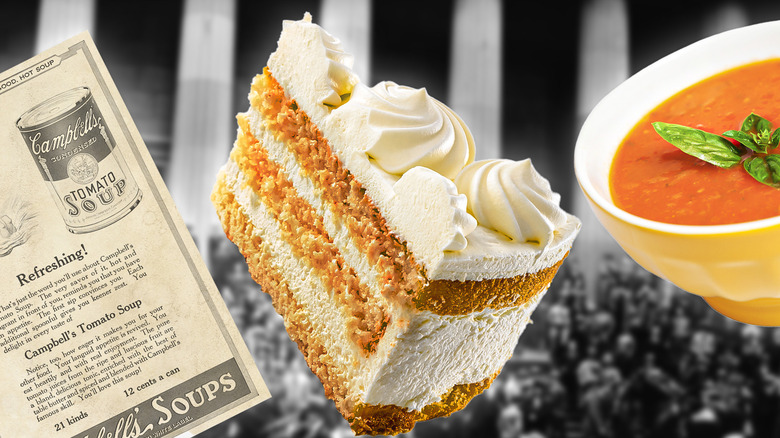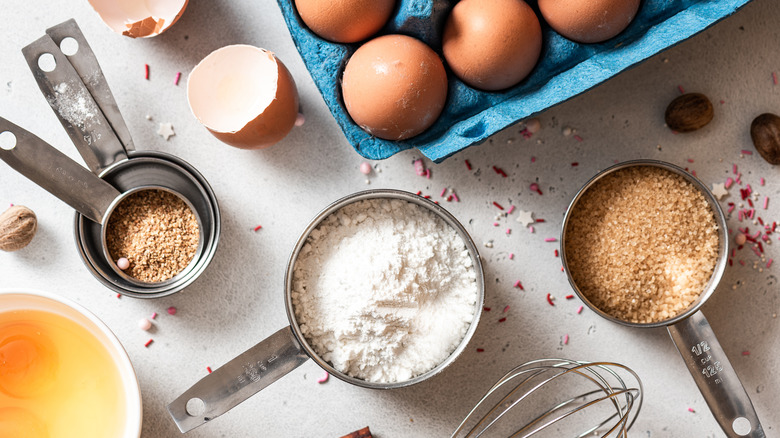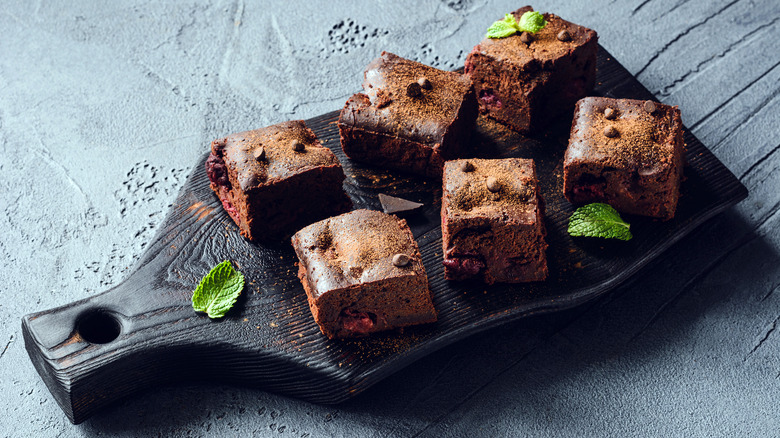Great Depression Era Tomato Soup Cake Is Still A Great Shortcut
If there's one thing that tomato soup cake proves, it's that come Hades, high water, or even the Great Depression and a couple of world wars, mankind will not be separated from the leanings of its sweet tooth. Tomato soup cake also proves that sometimes, the most unlikely ingredient combos taste good together, despite how wretched the mixture may sound in theory. Instead, the resulting confection tastes just like a spice cake should with no after hints of a marinara-like flavor whatsoever.
The question is, then, if it doesn't make the cake taste like anything other than a spice cake, why use tomato soup in it at all? It all comes down to the dearth of vital ingredients like eggs, milk, and butter during the years between World War I, the Great Depression, and World War II. Tomato soup cake first appeared in cookbooks in the early 1920s, though according to Atlas Obscura, no one knows who thought it up.
During that time, food rationing was both common and necessary. Many pantry staples, like dairy products, were diverted to the war effort and feeding the troops. Economics played a role in the rationing of certain foodstuffs, too. This was certainly the case during the Great Depression when everyone needed to tighten their financial belts. Home bakers got the short end of the stick. If they wanted baked goods at all, they needed to find substitutes for butter, eggs, and other dairy products. Enter tomato soup.
The chemistry of tomato soup cake
Given that mankind now lives in an era where cake often comes from a box mix and dairy products are as close as the nearest grocery store, it's easy to forget that pastry baking relies on actual high school chemistry class science to do its job. If you want a cake to rise, it needs a chemical reaction to do so. Being a quick bread-type cake, spice cake — aka tomato soup cake here — calls for baking soda.
The baking soda, if activated correctly, causes carbon dioxide bubbles to form in the cake. This eventually makes the cake rise. What activates baking soda is acid. Vinegar or buttermilk work in this case, but so, too, does a tomato-based something. The acids in the tomatoes become the buttermilk or vinegar substitute.
However, the tomatoes don't just replace the acids. Ingredients like eggs and milk hold a cake together, as well as add moisture to the recipe. In their absence, home cooks will sometimes use ingredients like applesauce. Apples contain pectin, so do tomatoes and tomato soup. Pectin stabilizes baked ingredients, allowing the ingredients to gel together and the cake to stand up. Without such ingredients, you end up with a flat cake. It really is basic chemistry in action, though the earliest makers of the cake may not have known that. They just knew that it worked and that the cake tasted good.
The evolution of the recipe
According to the Campbell's Company, the first known recipe for tomato soup cake appeared in an undated cookbook sometime in the 1920s, though the 1940s version of the recipe is the one that Campbell's calls "official." It went by the name "Steamed Fruit & Nut Pudding," and included sweet spices, like nutmeg, cinnamon, and cloves, as well as figs. Tomato soup showed up as the recipe's mystery ingredient. Given that it was a spice cake, it's probably little wonder that a version of it earmarked for Halloween celebrations appeared just two years later.
By the early 1950s, a chocolate version of the cake was unveiled. It, too, included tomato soup, though given the many quirky recipes from the 1950s, like Jello salad with shrimp, tomato soup cake probably fit right in with the sensibilities of mid-century modern cooking practices. People still make versions of tomato soup cake today, though the shortages of eggs, milk, and butter have mostly subsided. Newer iterations of the recipe can also include decadent frostings made from cream cheese and sugar (another ingredient that ended up on early 20th century rations lists).
As for why people make the cake now even though they don't have to, nostalgia and a longing for simpler times may have something to do with it. After all, most people keep tomato soup in their cupboards because it's a great comfort food accompaniment for grilled cheese sandwiches or even as a main ingredient in some old-fashioned spice cake.


